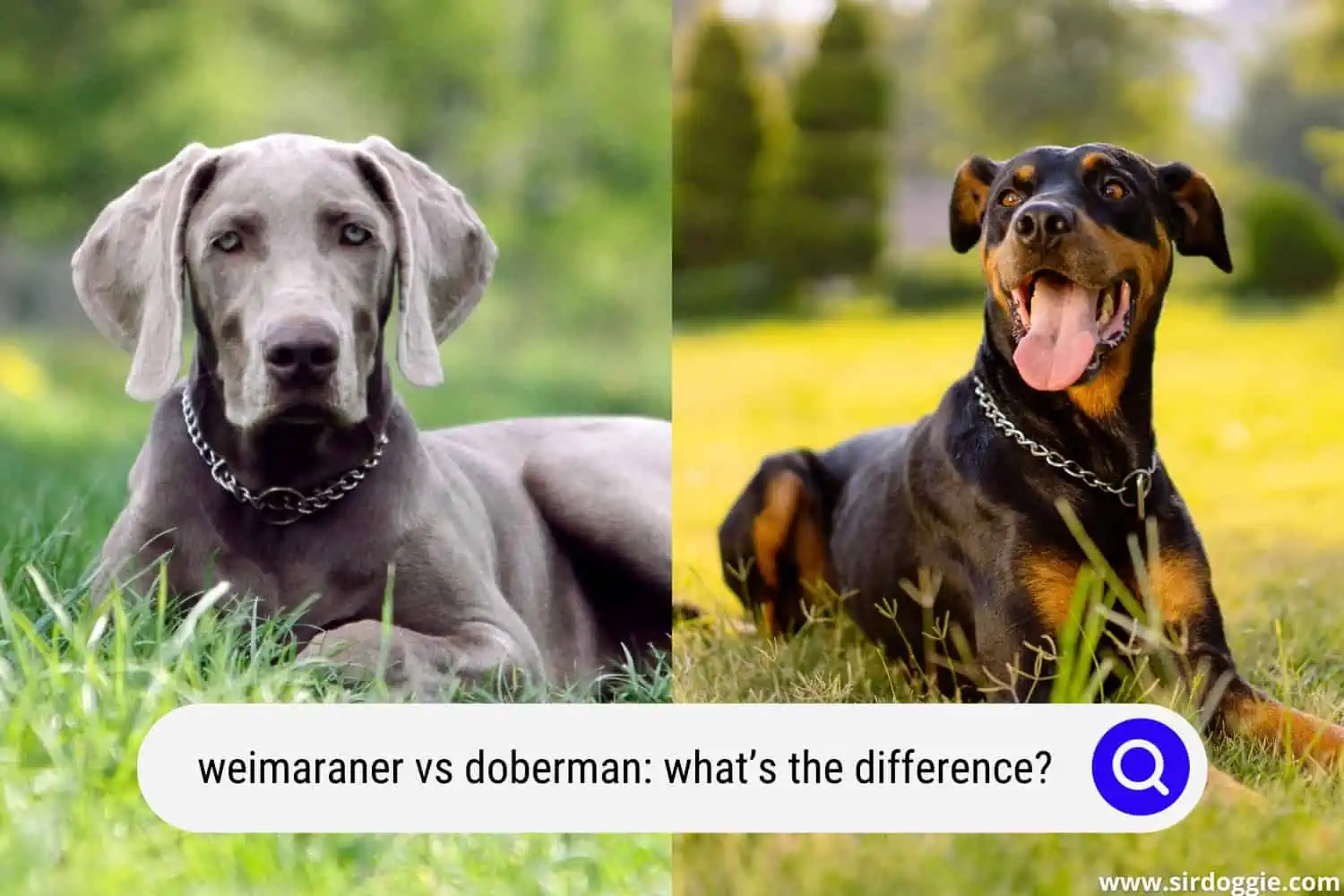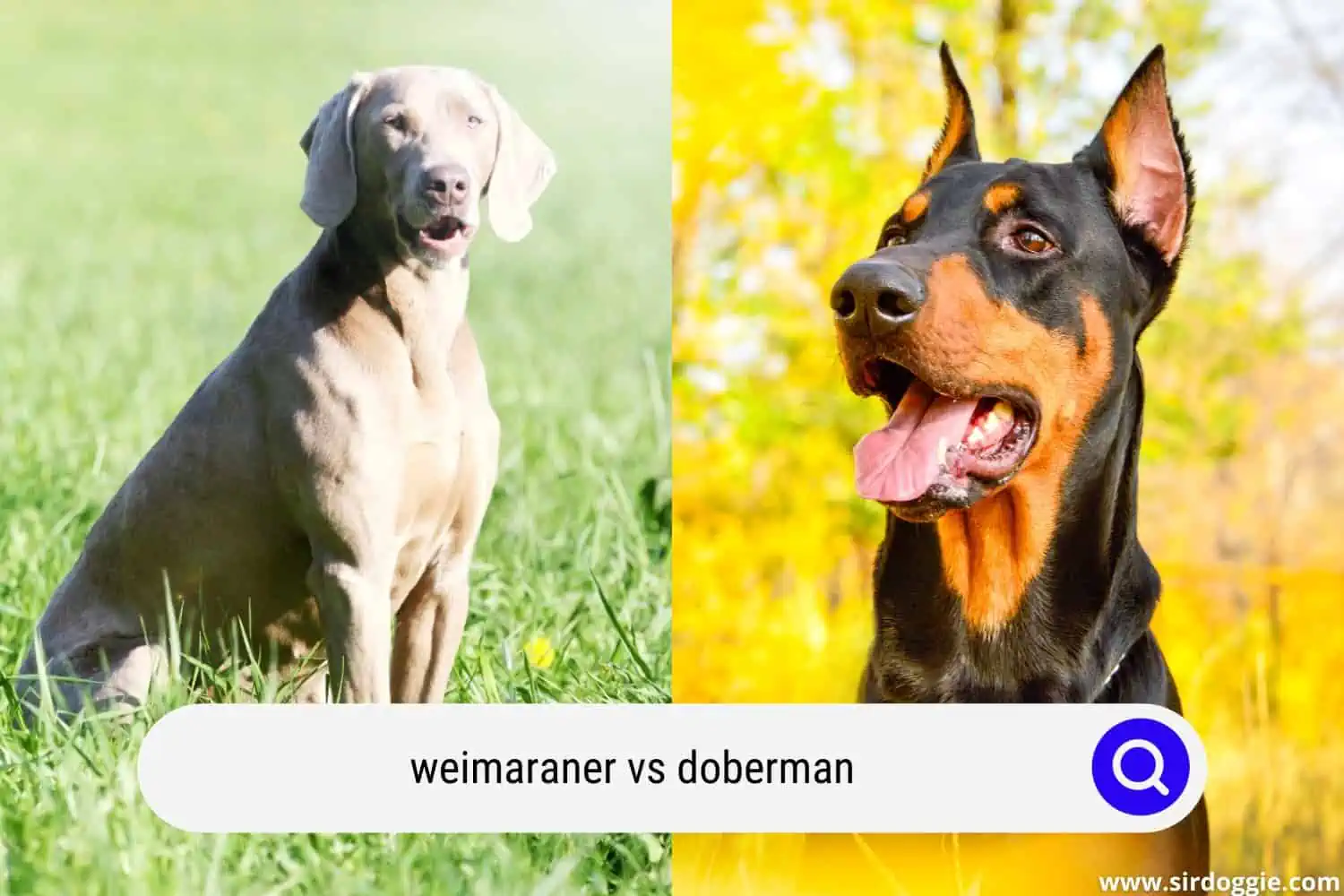Weimaraner vs Doberman: What’s the Difference?
Weimaraner is considered to be the oldest German pointing dog breed. It is fashionable in the US and bred there for appearance rather than performance and as a family dog. Meanwhile, the Doberman is known as an intelligent, brave, and loyal guard dog that is not ideal for beginners and requires consistent training.

Both breeds originated from Germany, and are family and apartment-friendly. But which is the best breed to choose: the Weimaraner or the Doberman?
In this Weimaraner vs Doberman comparison article, we’ll see the history, physical characteristics, temperament, and health life of the two breeds and tell you which one edges the other in a side-by-side comparison chart.
The Weimaraner Dog
Weimaraner Origin and History
The Weimaraner originates from Germany. However, the exact ancestry of the Weimaraner is unclear. There are various theories, e.g. that Arab greyhounds were involved in its creation or that mainly the German Shorthaired Pointer is its ancestor.
In the 17th and 18th centuries, Weimaraner-like dogs became popular again and again, depending on who was in power among the German nobility. It is documented that the Weimaraner was kept and bred for hunting in and around Weimar at the beginning of the 19th century.
At that time, still variable in appearance, breeding was purely about performance. Since 1897, the breed has been bred according to a uniform standard. Long-haired Weimaraners have also been around since around 1900, with the short-haired one becoming increasingly popular.
Since no foreign blood was crossed early on, the Weimaraner is considered to be the oldest German pointing dog breed. Unfortunately, this means that the breeding base is quite small, which brings with it the risk of excessive inbreeding.
In the US, the Weimaraner became fashionable through President Dwight Eisenhower’s bitch in the 1950s. There it is now bred more for appearance than for performance and is primarily kept as a family dog.
Weimaraner physical characteristics
The male of the Weimaraner measures 59-70 cm in height on average while the bitch can measure 57-65 cm at the withers. The weight of the male is around 30-40 kg while the female can weigh 25-35 kg on average.
There are long and short-haired Weimaraner dogs. The head is moderately long and broader in males than in females. The tail of the Weimaraner is strong and is inserted a little lower than the dorsal line. When the dog is active, it is carried slightly raised, but in a state of rest, it is hanging.
The muzzle is long and powerful, especially in males. The ears are wide, long, and rounded at the tips. In adults, the eyes are light to dark amber and have an expressive look. In puppies, the eyes are blue. The nose is dark red, gradually turning gray towards the back. Overall, it’s a medium to large dog that is robust and muscular.
Weimaraner Temperament and essence
According to the breeding regulations, the Weimaraner should be a versatile, easy-to-handle, steadfast, and passionate hunting dog.
The Weimaraner brings a lot of game heat, which means that it not only tracks down the game but also attacks and kills it if necessary.
This can be a problem when keeping the Weimaraner as a non-hunter. The Weimaraner can be used for pointing, searching, retrieving, and also for water work. It is persistent, and works in a concentrated manner, but does not tend to have an exuberant temperament. It is an extremely serious worker.
The watchful and protective instinct is much more pronounced than in most other hunting dog breeds. It is brave, extremely self-confident, and willing to take things into its own hands. Accordingly, it needs an experienced owner with assertiveness.
The Weimaraner is only suitable to a limited extent as a family dog. It is too serious and concentrated on tasks within a family as an everyday companion and playmate for the children. In general, it is also more of a one-man dog who only tolerates the rest of the family.
Often its strong guard instinct is underestimated, which distinguishes it from many other hunting dogs. It is not for nothing that it is also used as a protection dog, especially in the USA.
Weimaraner health
The dog is usually a healthy dog with a lower risk of inherited diseases. However, it sometimes experienced gastric torsion. Therefore, it is not recommended that exercise after or before eating. Other diseases that occur in the Weimaraner are spinal dysraphism, entropion, hemophilia, hip dysplasia, and von Willebrand.
The life expectancy of the Weimaraner is between 1 to 12 years.
Doberman Pinscher Dog
The Doberman Pinscher is best known for its excellent ability as a guard dog. It is a very brave and loyal dog and is by no means a beginner dog. It should be trained consistently from the start. With its size of approx. 70 cm and a weight of approx. 45 kg, the Doberman pinscher often looks very scary. Its life expectancy is 10-13 years.
Doberman Origin and History
The history of the Doberman begins in a small town in Thuringia called Apolda. A man named Friedrich Louis Dobermann needed a dog for protection at work, but it is not known what profession he did.
It is said, however, that Friedrich had an unpopular job such as a tax collector or night watchman. The only certain thing is that he was also an urban dog catcher and kept particularly vigilant four-legged friends for breeding with his bitch.
The ancestors of the Doberman breed are Rottweiler, German Shepherd, Great Danes, and Greyhounds. After the death of Friedrich Louis Dobermann, a friend took over the dog breeding and trained the Doberman to be a farm and working dog.
In 1899, the Dobermann Pinscher Club was founded by many breeders. The breed has been recognized as an official police dog since the 20th century. The Doberman was used in both world wars by the military as a reporting, mining, and medical dog.
Dobermans were found in concentration camps during World War II. The Doberman now often finds its place in families.
Doberman Physical characteristics
The Doberman Pinscher has short, hard, and dense fur in black, blue, or dark brown with a rust-colored tinge. The fur is smooth and evenly distributed over the entire body. It is a long-legged, slender dog with an elegant demeanor.
Unfortunately, you can still see a lot of docked specimens, which alone look dangerous. Fortunately, docking is now prohibited in many countries and has not been part of the FCI standard since 2015. With floppy ears and a long tail, the Doberman looks much more personable.
Doberman Temperament
Many representatives of this breed are downright cuddly. It needs a consistent but loving upbringing. Unfortunately, it is tough.
The Doberman Pinscher is usually obedient, brave, and spirited. Since it has a slight natural sharpness, it belongs in experienced hands. The best way to make it let off steam is to exercise its energy. It is very suitable for running on a bike or for dog sports. Good socialization should be important right from the start.
The Doberman Pinscher has a lot of sense of right and wrong and is always ready to intervene in case of doubt.
The Doberman is considered a classic one-man dog. It likes to be with a caregiver to whom it will be loyal. Nonetheless, it makes a good family dog. Ideally, the puppies should already be a bit taller to be able to withstand their temperament.
Doberman Health and Care
The Doberman Pinscher is generally an easy-care dog. Thanks to its short coat, it does not require any special care. However, the Doberman should wear a coat in winter, as it is very sensitive to cold due to its lack of undercoat. The Doberman prefers to stay warm in rain or snowfall.
There are some hereditary diseases seen in Dobermans. The most well-known hereditary disease here is the so-called “wobbler syndrome”.
This is a pathological change in the cervical spine. Usually, the disease occurs at the age of 6 or 7 in the Doberman and manifests itself in a variety of ways. The back becomes immobile, the dog begins to sway and the Doberman’s movement becomes very uncertain.
Weimaraner vs Doberman: a side-by-side comparison
| Weimaraner | Doberman pinscher | |
| Size | males: 59-70cm, females: 57-65cm | males: 68-72cm, female 63-68cm |
| Coat | Short hair: short, dense, smooth, without undercoat worth mentioning. Long hair: soft, long, with or without an undercoat | Short, hard, dense, without undercoat |
| Origin | Germany | Germany |
| Lifespan | 1 to 14 years | 1 to 12 years |
| Colour | Color: silver or mouse gray | black or brown with rust-red markings on the head, chest, and legs |
| Common diseases | allergies, occasionally hip dysplasia | wobbler syndrome, heart disease |
| Character | intelligent, fearless, energetic, obedient, intelligent, alert | fearless, energetic, obedient, intelligent, alert |
| Price | $500 to $1500 | $1,500 to $3,000 |

Conclusion
The Doberman is a relatively large dog that is characterized by its qualities as a guard dog. it is a very brave, intelligent, and loyal dog. The Dobermanns live between 10 and 13 years of age. The Dobermans are more expensive than Weimaraners.
Similar to the Dobermanns, the Weimaraners can live to be 10 to 14 years old. The Weimaraner is a dog that has been used for hunting, very versatile, energetic, intelligent, and very loyal. Also, it is somewhat shy and distrustful of strangers.
Regardless of the breed you’re choosing, you should be aware of the responsibilities and work you are getting into. You should also be aware that the dog will be part of your life for 10-14 years, that is a long time. You should give your Doberman a lot of attention and take it out with you as often as possible.

Family Dog Expert Author
Hi there! I’m Stuart, a devoted dog lover and family dog expert with over a decade of experience working with our furry companions. My passion for dogs drives me to share my knowledge and expertise, helping families build strong, loving bonds with their four-legged friends. When I’m not writing for SirDoggie, you’ll find me hiking, playing with my beautiful dog, or studying music.